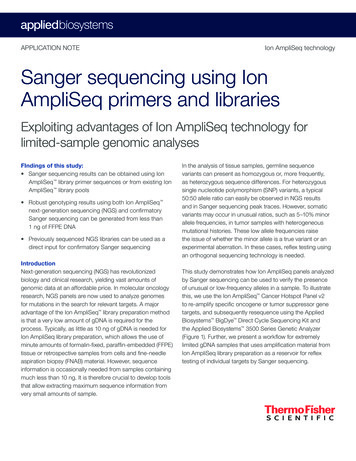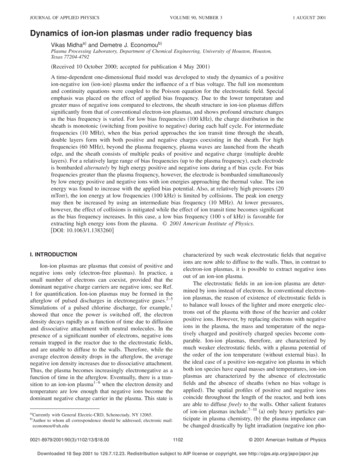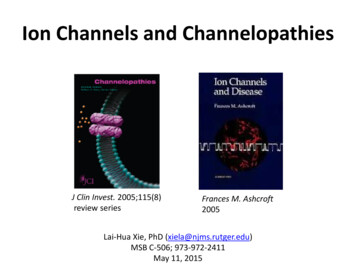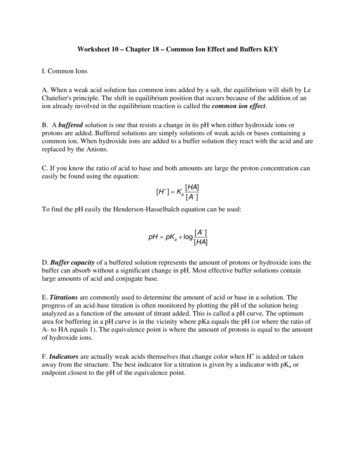
Transcription
APPLICATION NOTEIon AmpliSeq technologySanger sequencing using IonAmpliSeq primers and librariesExploiting advantages of Ion AmpliSeq technology forlimited-sample genomic analysesFIndings of this study: Sanger sequencing results can be obtained using IonAmpliSeq library primer sequences or from existing IonAmpliSeq library pools Robust genotyping results using both Ion AmpliSeq next-generation sequencing (NGS) and confirmatorySanger sequencing can be generated from less than1 ng of FFPE DNA Previously sequenced NGS libraries can be used as adirect input for confirmatory Sanger sequencingIntroductionNext-generation sequencing (NGS) has revolutionizedbiology and clinical research, yielding vast amounts ofgenomic data at an affordable price. In molecular oncologyresearch, NGS panels are now used to analyze genomesfor mutations in the search for relevant targets. A majoradvantage of the Ion AmpliSeq library preparation methodis that a very low amount of gDNA is required for theprocess. Typically, as little as 10 ng of gDNA is needed forIon AmpliSeq library preparation, which allows the use ofminute amounts of formalin-fixed, paraffin-embedded (FFPE)tissue or retrospective samples from cells and fine-needleaspiration biopsy (FNAB) material. However, sequenceinformation is occasionally needed from samples containingmuch less than 10 ng. It is therefore crucial to develop toolsthat allow extracting maximum sequence information fromvery small amounts of sample.In the analysis of tissue samples, germline sequencevariants can present as homozygous or, more frequently,as heterozygous sequence differences. For heterozygoussingle nucleotide polymorphism (SNP) variants, a typical50:50 allele ratio can easily be observed in NGS resultsand in Sanger sequencing peak traces. However, somaticvariants may occur in unusual ratios, such as 5–10% minorallele frequencies, in tumor samples with heterogeneousmutational histories. These low allele frequencies raisethe issue of whether the minor allele is a true variant or anexperimental aberration. In these cases, reflex testing usingan orthogonal sequencing technology is needed.This study demonstrates how Ion AmpliSeq panels analyzedby Sanger sequencing can be used to verify the presenceof unusual or low-frequency alleles in a sample. To illustratethis, we use the Ion AmpliSeq Cancer Hotspot Panel v2to re-amplify specific oncogene or tumor suppressor genetargets, and subsequently resequence using the AppliedBiosystems BigDye Direct Cycle Sequencing Kit andthe Applied Biosystems 3500 Series Genetic Analyzer(Figure 1). Further, we present a workflow for extremelylimited gDNA samples that uses amplification material fromIon AmpliSeq library preparation as a reservoir for reflextesting of individual targets by Sanger sequencing.
Confirmation by SangersequencingData analysis usingSequence ScannerSoftware or MinorVariant Finder ToolAFFPE gDNAPrimer Designer Tool—choose amplicons 200 bpBFFPE gDNANGS usingIon AmpliSeq panelPrimer Designer Tool—choose amplicons 200 bpConfirmation by SangersequencingIon AmpliSeq librarypoolPrimer Designer Tool—choose amplicons 200 bpConfirmation by SangersequencingData analysis usingNGC module or MinorVariant Finder ToolCData analysis usingNGC module or MinorVariant Finder ToolFigure 1. Three scenarios for variant confirmation.Ion AmpliSeq primer design and conversion to SangerPCR primersThe Ion AmpliSeq Cancer Hotspot Panel v2 used for thisstudy is a single pool of amplification primers for targetedsequencing of genes frequently mutated in humantumor samples. This panel is designed to amplify 207amplicons covering approximately 2,800 Catalogue OfSomatic Mutations In Cancer (COSMIC) mutations from50 oncogenes and tumor suppressor genes in a singlemultiplex PCR (Figure 2). PCR primer sequences for othercommercial Ion AmpliSeq panels and Ion AmpliSeq Community Panels are available for downloadat ampliseq.com.Before using the Ion AmpliSeq primers for Sangersequencing, universal M13 primer sequences mustbe added to the 5 ends of the Ion AmpliSeq forwardand reverse primers. In this study, the M13 forwardprimer sequence 5 -TGTAAAACGACGGCCAGT-3 was added to the 5 end of the Ion AmpliSeq forwardprimer sequence, and the M13 reverse primer sequence5 -CAGGAAACAGCTATGACC-3 was added to the 5 endof the Ion AmpliSeq reverse primer sequence. Alternatively,native or M13-modified primer pairs from the Ion AmpliSeqCancer Hotspot Panel v2 can be ordered using the PrimerDesigner Tool at thermofisher.com/primerdesignerStreamlined PCR-to-sequencing workflowIn this study, we used the DNA control sample (CEPH-02),which is included in the BigDye Direct Cycle SequencingKit, for intact DNA. We also used a mixture of two CoriellInstitute DNA samples, referred to as NA8020. For FFPEDNA preparations, we extracted DNA from FFPE tissuesections. We used the BigDye Direct Cycle Sequencing Kitfor integrated PCR and sequencing of individual targets.For post-PCR cleanup after cycle sequencing, BigDye Xterminator bead suspension was added to the reactionsand vigorously vortexed for 20–30 min, followed bycentrifugation for 1 min to pellet the beads. The plate wasloaded on a 3500 Series Genetic Analyzer, and capillaryelectrophoresis was performed using a rapid run module.For details, see the Appendix.Figure 2. Excerpt of the PCR primer data sheet for the Ion AmpliSeq Cancer Hotspot Panel v2. Shown are the first 10 of the207 amplicons. Genome coordinate annotations and hyperlinks to COSMIC and SNP databases as well as the UCSC GenomeBrowser are available at ampliseq.com.
Sanger sequencing data analysis toolsThere are several options for analyzing Sanger sequencingdata, depending on the needs and the complexity ofthe project: Sequence Scanner Software—a free download ofthis software, which is useful for visual inspection andbase calling, can be obtained at thermofisher.com/sangersoftware Applied Biosystems Variant Reporter Software—downloadable desktop software specialized for detectionand reporting of typical Mendelian inheritance mutations,such as heterozygous or homozygous single nucleotidevariations (SNVs) or short insertions or deletions (indels);can be obtained at thermofisher.com/sangersoftware Minor Variant Finder Tool—specialized desktopsoftware for enhanced and automated detection ofminor variants in Sanger sequencing traces; can beobtained at thermofisher.com/mvf Thermo Fisher Cloud NGC module—a specializedcloud-based application that enables direct side-by-sidecomparison of variants from NGS-derived .vcf files andSanger sequencing files and generates a comprehensivereport; available at apps.thermofisher.com (requiresregistration)For the data analysis described below, sequencing data files(.ab1 files) were analyzed with Sequence Scanner Software,and QC reports were generated and exported as tablesreadable in Microsoft Excel software (Figure 3). The Excelfile with the QC data was further analyzed using an Excelsoftware macro, and the sample files were flagged with anumerical penalty flag ( 1) according to the following criteria:trace score is 40, contiguous read length is 100, QV20bases is 100, signal strength RFU for the (A) trace is 300.If the trace score was below 30, the trace file was givena penalty of 4 and called as failed. A combined score isgenerated by adding the number of flags:Score result 0: good dataScore result 1: mostly good data; may requirevisual reviewScore result 2: lower-quality data; usable after manualreview, but stretches of poor datamay existScore result 3 or more: very poor data quality;not usable1 ng of input DNA can be used for Sanger sequencingof individual Ion AmpliSeq targetsWe established the workflow and protocol for resequencingof individual hotspot targets by using 48 ampliconsrepresenting a subset of the Ion AmpliSeq Cancer HotspotPanel v2 targets. In addition, we tested 24 Ion AmpliSeqpanel targets covering the exons of the human TP53 gene.For DNA samples, we used the CEPH-02 control gDNAthat is included in the BigDye Direct Cycle Sequencing Kit;a mixture of two Coriell Institute DNA samples, referred toas NA8020; and two DNA preparations from FFPE tissuesections, referred to as FFPE 1 and FFPE 5.Figure 3. Generating and exporting results using Sequence Scanner Software. A QC report was generated and exportedfor further analysis in Excel software.
To determine the minimal amount of gDNA that is neededfor robust Sanger sequencing of Ion AmpliSeq paneltargets, we diluted CEPH-02 gDNA to 2.5 ng/µL, 1 ng/µL,0.5 ng/µL, and 0.125 ng/µL for use as input DNA in individualPCR reactions using a subpanel of 24 primer pairs. Robustamplification and sequencing was obtained with as littleas 1 ng of input DNA. Lowering the amount to 0.5 ng perreaction still yielded good results for over 80% of assays, butdata quality for some amplicons started to deteriorate in thisrange. Data quality further deteriorated when the amountwas lowered to 0.125 ng per reaction, but nearly 80% ofassays produced usable sequencing data even with thisvery low amount of input DNA. Taken together, these resultsshow that 1 ng of gDNA is an acceptable minimal amountof template DNA for both forward and reverse sequencingreactions using the BigDye Direct Cycle Sequencing Kit.1 ng of FFPE DNA can be used for Sanger sequencingof individual Ion AmpliSeq targetsAlthough FFPE tissue is a standard sample type in histologyand pathology laboratories, the fixation process damagesDNA and makes it a challenging sample type for moleculargenetic analysis. To determine the compatibility of IonAmpliSeq panel primer designs with the BigDye Direct CycleSequencing Kit workflow (Figure 1, workflow A and B), weused two DNA preparations from FFPE tissue sections,FFPE 1 and FFPE 5. Here we used the Ion AmpliSeq primerdesigns for 24 coding segments of the human TP53 gene(available at ampliseq.com). Similar to our findings withintact genomic DNA, we found that all 24 segments weresuccessfully amplified and sequenced at an input amount of1 ng DNA per PCR reaction. These results demonstrate thatDNA extracted from FFPE-preserved samples is suitablefor Sanger sequencing using M13-modified Ion AmpliSeqprimer sets.Diluted Ion AmpliSeq library is reservoir for PCRof individual targets of interestGenomic DNA20 µLMultiplex PCRIon AmpliSeq primer poolTake 1 µL (5%) of Ion AmpliSeq PCR poolDilute in 1 mL TE bufferPCR of individual target with specific primer pair(M13-tagged)19 µLPartially digest primer sequencesForward (F) and reverse (R) Sanger sequencingwith the BigDye Direct Cycle Sequencing KitAdaptersORAdaptersFAP1XP1AXP1ORConfirm variant with Sequence Scanner Softwareor Minor Variant Finder ToolNonbarcoded libraryP1Barcoded libraryFigure 4. The Ion AmpliSeq library pool as a reservoir for Sanger sequencing of individual amplicons. The Ion AmpliSeq library preparationworkflow is shown on the left. The PCR amplification material from the first step (the initial multiplex PCR) is the source of the Sanger sequencingreservoir. A 1 µL aliquot, representing approximately 5% of the amplification reaction, is taken before the library is further processed and is dilutedin 1 mL of TE buffer. This material contains an enrichment of the targets of interest, which are typically amplified for 17 cycles. Assuming ideal PCRconditions and efficiency, it is estimated that each target is present at around 1,000–2,000 copies/µL in the 1:1,000 dilution (in 1 mL TE) of the aliquot;1 µL of this dilution is then used as input DNA template in the PCR reaction using the BigDye Direct Cycle Sequencing Kit.
Table 1. Mutation frequencies observed for the TP53 gene following amplification using an Ion AmpliSeqCommunity Panel and NGS on an Ion 318 Chip.FFPE 5TP53 10.1.470(TP53 02)chr17:7578645C TTP53 11.1324631(TP53 08)chr17:7579472G CTP53 8.884088(TP53 23)chr17:7578115T CTP53 10.215568(TP53 5)chr17:7578406C T21.8%20.2 %17.9 %60.6%Minor variants can be verified by Sanger sequencingof an Ion AmpliSeq library poolIn many instances, the small size and limited amount ofDNA extracted from a sample limits further confirmatoryanalyses. Nevertheless, alleles appearing at low frequencies(10–20%) should be confirmed by orthogonal techniques.One other source of DNA for such analyses is the IonAmpliSeq library pool generated for NGS. Sequencespresent in these libraries reflect the endogenous allelesin the sample, but because they are amplified, they areless limiting. We therefore determined whether SangerGCTAGCCGForwardForwardReversesequencing of individual Ion AmpliSeq targets directly froma preexisting Ion AmpliSeq library pool would reflect theallele frequencies of the unamplified DNA source (Figure 1,workflow C). We used a retained aliquot (1 µL, approximately5%) of the original FFPE 5 Ion AmpliSeq library material. Adilution of this aliquot was used as a template for specific,individual PCR and sequencing reactions. This workflow isillustrated in Figure 4. Mutation frequencies observed forthe TP53 gene after NGS are shown in Table 1, and Sangersequencing results are shown in Figure 5. The frequenciesof the alleles observed by NGS and Sanger sequencingATGCReverseReverseForwardFigure 5. Corresponding Sanger sequencing traces for minor variants previously detected by NGS (Table 1). All minor variants could be visuallyconfirmed using Sequence Scanner Software as discrete “peak under peak” entities in approximate proportion to the NGS results in both forward andreverse strands.
correlated very well. Thus, Sanger sequencing of theAmpliSeq library pool can be used to verify allele frequenciesin the original sample DNA.ConclusionsWe have shown that Ion AmpliSeq multiplex PCR primerdesign can be readily converted to a singleplex PCRprimer pair design by attaching M13 tags to forward andreverse primers, allowing robust PCR amplification andSanger sequencing from limited amounts of genomicDNA (0.5–1 ng per PCR reaction). Ion AmpliSeq primersequences are available at ampliseq.com or searchable andorderable from the Primer Designer Tool at thermofisher.com/primerdesigner. When DNA availability is extremelylow, the amplification product generated as a first step inthe Ion AmpliSeq library preparation process can serve asa potential reservoir for reflex testing by PCR and Sangersequencing. However, the method is not yet optimizedfor high-complexity Ion AmpliSeq panels, such as theOncomine Comprehensive Assay or human exome panel.These data demonstrate that researchers needing a fastand economical solution for confirmation of uncertain NGSresults can rely on the robustness and sensitivity of PCRcoupled with Sanger sequencing.Appendix—protocolPrimer design and ordering summary1. Add an M13 forward tag (5 -TGTAAAACGACGGCCAGT-3 ) to the 5 end of the Ion AmpliSeq forward primer,and an M13 reverse tag (5 -CAGGAAACAGCTATGACC-3 )to the 5 end of Ion AmpliSeq reverse primer.2. Order oligonucleotides using the Invitrogen CustomDNA Oligos service or through the Primer Designer Tool(25 nmol synthesis scale and desalted purification issufficient for 100 PCR reactions).3. Resuspend oligonucleotides in TE buffer to 100 µM(primer stock).4. Generate a working solution of the primer pair (10 µMeach) by combining 10 µL of the forward primer stockwith 10 µL of the reverse primer stock and diluting theminto 80 µL of deionized water or TE buffer.Set up PCR amplificationA typical PCR reaction for bidirectional sequencing is setup in an Applied Biosystems MicroAmp Standard or FastOptical 96-Well Reaction Plate as described below.Combine:10 µL BigDye Direct PCR Master Mix (included in kit)2 µL PCR primer pair with M13 tags (10 µM each)7 µL deionized water1 µL DNA template (typically 1 ng) or 1 µL diluted (i.e.,1:1,000) Ion AmpliSeq post-PCR poolCover the plate with Applied Biosystems MicroAmp Optical Adhesive Film and perform PCR using an AppliedBiosystems Veriti 96-Well Fast Thermal Cycler (or similar)using this profile:Stage 1: 94 C for 10 min (1x)Stage 2: 9 5 C for 3 sec, 60 C for 15 sec, 68 C for45 sec (8x)Stage 3: 95 C for 3 sec, 70 C for 50 sec (28x)Stage 4: Hold at 4 CNote: Only half of the plate is used for PCR (i.e., 48 samplesin columns 1–6 to allow the later use of columns 7–12 for thereverse sequencing reaction).Preparing the sequencing mixThe BigDye Direct Sequencing Master Mix contains anuclease that degrades the remaining PCR primers whenit comes in contact with the PCR material. This obviatesthe need for and cost of any further PCR purification. TheBigDye Direct Sequencing Master Mix is simply combinedin a 2:1 ratio with an M13 sequencing primer (either forwardor reverse), which is chemically modified to be nucleaseresistant. A sufficient quantity of modified nuclease-resistantM13 forward and reverse sequencing primers is suppliedwith the kit.
BigDye Direct PCR reactionwith M13-tagged Ion AmpliSeqprimer pair:Split into two: transfer 9.8 µLinto a fresh well20 µL (at setup) 19.6 µL (after PCR)Add 3 µL of forward sequencingmix (combine 2 µL BigDye DirectSequencing Master Mix and 1 µLforward primer)9.8 µLremainsin wellAdd 3 µL of reverse sequencingmix (combine 2 µL BigDye DirectSequencing Master Mix and 1 µLreverse primer)Figure 6. Streamlined PCR-to-sequencing workflow. The PCR reaction is split into 2 wells, and sequencing mix is added to each well. Cyclesequencing is then performed.Splitting the PCR material for forward andreverse sequencingBefore adding the complete BigDye Direct SequencingMaster Mix plus primer (total of 3 µL), the PCR reactionneeds to be split in half: one for the forward and one forthe reverse sequencing reaction (Figure 6). This is done bytransferring 9.8 µL of PCR material into free wells on thePCR plate with a multichannel pipettor (e.g., wells A–H ofcolumn 1 go into A–H of column 7). After splitting the PCRreactions, 3 µL of the appropriate sequencing mix (forwardor reverse) is added to each well and the reaction mix issubjected to cycle sequencing.Cycle sequencing is performed on the Veriti 96-Well FastThermal Cycler using this profile:Stage 1: 37 C for 20 min (1x)Stage 2: 80 C for 2 min (1x)Stage 3: 96 C for 1 min (1x)Stage 4: 96 C for 3 sec, 50 C for 5 sec, 60 C for45 sec (27x)Stage 5: Hold at 4 CAfter cycle sequencing, 50 μL of BigDye Xterminatorbead suspension is added to the reactions and vigorouslyvortexed for 20–30 min followed by centrifugation for 1 minto pellet the beads. The plate is now ready for capillaryelectrophoresis on the 3500 Series Genetic Analyzer.Capillary electrophoresis is performed using a rapid runmodule that delivers sequence data files in 45 minutes.
Find out more at thermofisher.com/primerdesignerFor Research Use Only. Not for use in diagnostic procedures. 2016 Thermo Fisher Scientific Inc. All rights reserved.All trademarks are the property of Thermo Fisher Scientific and its subsidiaries unless otherwise specified. Excel is a trademarkof Microsoft Corp. CO37831 0216
primer sequence 5 -TGTAAAACGACGGCCAGT-3 was added to the 5 end of the Ion AmpliSeq forward primer sequence, and the M13 reverse primer sequence 5 -CAGGAAACAGCTATGACC-3 was added to the 5 end of the Ion AmpliSeq reverse primer sequence. Alternatively, native or M13-modifi ed primer pairs from the Ion AmpliSeq










